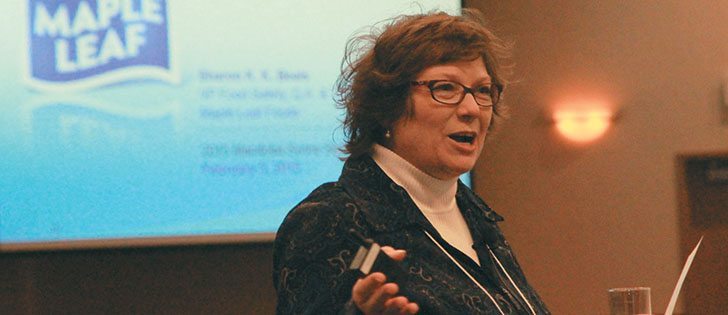Tainted meat recalls cost money and tarnish the reputation of the meat industry, says a food safety official
Pharmaceutical residues can sneak into market hogs even when producers are being careful, says Maple Leaf Foods’ vice-president for safety.
And when they do, it costs significant money and endangers the reputations of farmers and meat companies.
“Somebody’s got to pay,” Sharon Beals told the Manitoba Swine Seminar Feb. 5. “It comes out of somebody’s pocket.”
The costs can arise from tracking down and destroying tainted meat or from segregating animals until medical residues are naturally eliminated.
The biggest danger is to consumer demand for products that the public needs to know are safe to eat.
Read Also

Final crop reports show strong yields, quality
Crops yielded above average across the Prairies this year, and quality is generally average to above-average.
Beals described three cases in which pharmaceutical residues showed up in pigs arriving at their facilities. In one case, the residues were found long after the pigs had been slaughtered and the meat shipped.
The two most serious of the three cases were unintentional exposure of the pigs to pharmaceuticals that the farmer did not intend to provide to the market hogs.
In the first case, which affected $7.7 million worth of meat, a farmer and his veterinarian discovered that they had been incorrectly receiving medicated feed at a multiplier operation, from which 100 pigs per week were shipped to the slaughterhouse.
The feed mill that supplied the feed had been making a mistake with their order for four months.
They immediately informed Maple Leaf, which then scrambled to find out what had happened to the meat.
“I’ve got product in the marketplace. I’ve got product on the water. I’ve got $7.7 million worth of product at risk,” said Beals.
Fortunately, the residue levels of the pharmaceutical in muscle cuts weren’t above acceptable limits for health, so people weren’t in danger. However, the company had to hunt down the meat products that still existed and destroy them.
About half still existed.
The most dangerous parts — the kidneys and liver where pharmaceutical residues concentrate — were found in a container on the ocean that could be intercepted before being consumed.
A little less than half the meat products had already been consumed.
The second case revealed an unexpected cause of pharmaceutical residue contamination: “bored pigs eat poop.”
A farmer had shipped market hogs to Maple Leaf that showed up positive in a routine test for a medication to which they should not have been exposed.
The farmer was shocked. How had that occurred? His feed contained no medication.
He realized he had shipped the market hogs in the same trailer he had previously used to ship weanlings, which had been eating medicated feed. The market hogs had been snacking on the weanling manure in the truck, and the drug taint had quickly metabolized.
Fortunately, the drug was not a human health risk or $250,000 of pork products would have been destroyed.
In the third case, a load of hogs was randomly tested and found positive for a medication they should not have had by slaughter time.
The pigs were pulled aside for a few days until the residue disappeared, which cost $10,000.
















